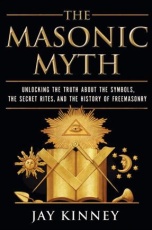 Excerpt
from The Masonic Myth: Unlocking the Truth About the Symbols, the Secret Rites, and the History of Freemasonry
Excerpt
from The Masonic Myth: Unlocking the Truth About the Symbols, the Secret Rites, and the History of Freemasonry
by Jay Kinney
Introduction
Normally, public tours of Freemasons' Hall are provided daily, but by happenstance the tours were not available on the day we first visited there. It was the day of the Grand Lodge's quarterly communication, when representatives from lodges and provincial bodies around England meet to take care of business. Do come again another day, we were told, and you'll be able to take a tour.
And then a most curious sight unfolded before our eyes as we turned to leave and stood at the top of the steps leading down to the street from the side entrance. A series of black taxicabs pulled up to the curb in front of Freemasons' Hall and proceeded to emit nearly identical passengers: the proverbial Men in Black -- men dressed in black suits with black neckties, all carrying black briefcases. The men -- all Masons -- ran up the steps and through the doors of Freemasons' Hall as more taxis arrived, emitting more Men in Black.
Was this real life, or had we somehow stumbled into a scene from a Monty Python movie? To our American eyes, it was an almost comical sight, but I also felt a tiny shiver go up my spine. Masonry has been accused by some of being a cult, and the scene before us didn't exactly disprove the accusation. What had I gotten myself into, exactly?
It didn't take long for me to deconstruct the strangeness of the Men in Black episode. The quarterly meeting was about to begin. The arriving Masons had likely taken trains into London and caught cabs to take them to Freemasons' Hall. Most London taxis of that era were black, for reasons having nothing to do with Masonry. Unlike much of American Masonry, English Masonry has had a simple but narrow dress code for its meetings: white shirt, black suit and tie. (In a culture still given to subtle class distinctions such as old school ties, the requirement of a simple black tie for all can enhance the feeling of brotherhood.) And the black briefcases? Those were actually apron cases, in which brethren keep the ceremonial aprons that are worn during Masonic meetings. (The aprons commemorate the workmen's aprons used by the stonemasons, the supposed ancestors of modern Freemasonry.)
However, it would be a matter of years before I was able to answer the deeper question of what I had gotten myself into.
There are any number of legitimate questions that arise when one tries to grasp what Masonry is. Is it really a secret society -- and if so, why all the secrecy? Where did it really come from? What's with all the ritual and regalia? Why the grandiose titles and honorifics? What's with the proliferation of degrees and orders and interrelated Masonic side organizations? And, when all is said and done, what's the point of all this rigmarole? Is there some secret payoff that justifies the enormous amount of time and effort that has been spent over centuries in maintaining this enigmatic institution?
Because the answers to these questions are not self-evident -- even to some Masons, and especially to non-Masons -- a barrage of pseudo-answers has too often rushed in to fill the void. Some of these, such as the imaginative speculations of "alternative historians," are harmless enough, at least if they aren't mistaken for historical facts. But other explanations, especially those of hostile anti-Masons, are dangerous, not merely to Masons but to society at large. The Nazis rose to power in Germany in part by scapegoating Jews and Masons, while in the present era Masonic lodges have been the target of Islamist terrorists. Dark accusations about Freemasonry as a satanic cult or a tool of a hidden power elite may be bestsellers for many publishers, but such pseudo-answers poison the well of public knowledge with delusional claims and paranoid misinterpretations.
Of course, everyone loves a good yarn, which is partly why Dan Brown's books have been so popular. Secretive brotherhoods can be excellent devices in suspense thrillers, but novels are, by their very nature, fiction. A novelist can make those links that raise the hair on one's neck, and a good writer can make you believe them. But once the novel is over, it is good to do a reality check. They say that truth is stranger than fiction. Let's see if that's true.
The above is an excerpt from the book The Masonic Myth: Unlocking the Truth About the Symbols, the Secret Rites, and the History of Freemasonry by Jay Kinney. The above excerpt is a digitally scanned reproduction of text from print. Although this excerpt has been proofread, occasional errors may appear due to the scanning process. Please refer to the finished book for accuracy.
Copyright © 2009 Jay Kinney, author of The Masonic Myth: Unlocking the Truth About the Symbols, the Secret Rites, and the History of Freemasonry
